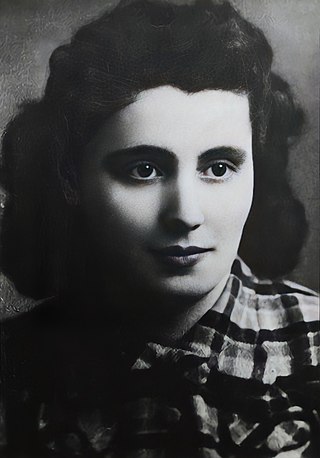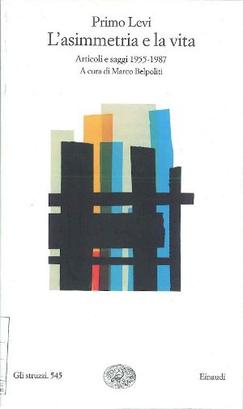
Primo Michele Levi was a Jewish-Italian chemist, partisan, writer, and Holocaust survivor. He was the author of several books, collections of short stories, essays, poems and one novel. His best-known works include If This Is a Man, his account of the year he spent as a prisoner in the Auschwitz concentration camp in Nazi-occupied Poland; and The Periodic Table (1975), a collection of mostly autobiographical short stories each named after a chemical element as it played a role in each story, which the Royal Institution named the best science book ever written.
This is a selected bibliography and other resources for The Holocaust, including prominent primary sources, historical studies, notable survivor accounts and autobiographies, as well as other documentation and further hypotheses.
The Białystok Ghetto uprising was an insurrection in the Jewish Białystok Ghetto against the Nazi German occupation authorities during World War II. The uprising was launched on the night of August 16, 1943 and was the second-largest ghetto uprising organized in Nazi-occupied Poland after the Warsaw Ghetto Uprising of April–May 1943. It was led by the Anti-Fascist Military Organisation, a branch of the Warsaw Anti-Fascist Bloc.
During World War II, resistance movements operated in German-occupied Europe by a variety of means, ranging from non-cooperation to propaganda, hiding crashed pilots and even to outright warfare and the recapturing of towns. In many countries, resistance movements were sometimes also referred to as The Underground.
The Holocaust has been a prominent subject of art and literature throughout the second half of the twentieth century. There is a wide range of ways–including dance, film, literature, music, and television–in which the Holocaust has been represented in the arts and popular culture.

The Vilna Ghetto was a World War II Jewish ghetto established and operated by Nazi Germany in the city of Vilnius in the modern country of Lithuania, at the time part of the Nazi-administered Reichskommissariat Ostland.

If This Is a Man is a memoir by Jewish Italian writer Primo Levi, first published in 1947. It describes his arrest as a member of the Italian anti-fascist resistance during the Second World War, and his incarceration in the Auschwitz concentration camp (Monowitz) from February 1944 until the camp was liberated on 27 January 1945.
The history of the Jews during World War II is almost synonymous with the persecution and murder of Jews which was committed on an unprecedented scale in Europe and European North Africa. The massive scale of the Holocaust which happened during World War II greatly affected the Jewish people and world public opinion, which only understood the dimensions of the Final Solution after the war. The genocide, known as HaShoah in Hebrew, aimed at the elimination of the Jewish people on the European continent. It was a broadly organized operation led by Nazi Germany, in which approximately six million Jews were murdered methodically and with horrifying cruelty. Although the Holocaust was organized by the highest levels of the Nazi German government, the vast majority of Jews murdered were not German, but were instead residents of countries invaded by the Nazis after 1938. Of the approximately 6 million Jews murdered by the Nazis, approximately 160,000 to 180,000 were German Jews. During the Holocaust in occupied Poland, more than one million Jews were murdered in gas chambers of the Auschwitz concentration camp alone. The murder of the Jews of Europe affected Jewish communities in Albania, Austria, Belarus, Belgium, Bosnia & Herzegovina, Channel Islands, Croatia, Czech Republic, Estonia, France, Germany, Greece, Hungary, Italy, Latvia, Libya, Lithuania, Luxembourg, Moldova, the Netherlands, North Macedonia, Norway, Poland, Romania, Russia, Serbia, Slovakia, and Ukraine.

Jewish resistance under Nazi rule took various forms of organized underground activities conducted against German occupation regimes in Europe by Jews during World War II. According to historian Yehuda Bauer, Jewish resistance was defined as actions that were taken against all laws and actions acted by Germans. The term is particularly connected with the Holocaust and includes a multitude of different social responses by those oppressed, as well as both passive and armed resistance conducted by Jews themselves.

In Poland, the resistance movement during World War II was led by the Home Army. The Polish resistance is notable among others for disrupting German supply lines to the Eastern Front, and providing intelligence reports to the British intelligence agencies. It was a part of the Polish Underground State.

Muselmann was a term used amongst prisoners of German Nazi concentration camps during the Holocaust of World War II to refer to those suffering from a combination of starvation and exhaustion, as well as those who were resigned to their impending death. The Muselmann prisoners exhibited severe emaciation and physical weakness, an apathetic listlessness regarding their own fate, and unresponsiveness to their surroundings owing to their barbaric treatment.

The Ghetto Fighters' House, is a Holocaust museum founded in 1949 by members of Kibbutz Lohamei Hagetaot.

Jewish partisans were fighters in irregular military groups participating in the Jewish resistance movement against Nazi Germany and its collaborators during World War II.

Malka Zimetbaum, also known as "Mala" Zimetbaum or "Mala the Belgian", was a Belgian woman of Polish Jewish descent, known for her escape from the Auschwitz-Birkenau concentration camp. She is also remembered for her lifesaving acts in favor of other prisoners during her captivity at Auschwitz and for the resistance she displayed at her execution following her being recaptured, when she tried committing suicide before the guards were able to execute her, then slapped the guard who tried to stop her, before eventually being killed. She was the first woman to escape from Auschwitz.
Shalom Yoran was a survivor of the Holocaust and a former Jewish partisan. His World War II memoir, The Defiant. A True Story of Jewish Vengeance and Survival, was first published in 1996.

Liana Millu was a Jewish-Italian journalist, World War II resistance fighter and Holocaust survivor. She is best known for her 1947 autobiography Smoke over Birkenau, translated to English as Smoke over Birkenau.

The Black Hole of Auschwitz is a collection of essays by the Italian author Primo Levi. Originally published under the Italian title L'asimmetria e la vita it has two distinct halves. The first half, The Black Hole of Auschwitz is a collection of essays, often prefaces to other books, which make a plea against Holocaust denial. The second half, Other People's Trades, is a mixture of essays on a wide variety of subjects. All of these works were collected together in the production of the Italian anthology of Levi's works, Opere, in 1997.

Yehiel De-Nur, also known by his pen name Ka-Tsetnik 135633, born Yehiel Feiner, was a Jewish writer and Holocaust survivor, whose books were inspired by his time as a prisoner in the Auschwitz concentration camp.
The Fossoli camp was a concentration camp in Italy, established during World War II and located in the village Fossoli, Carpi, Emilia-Romagna. It began as a prisoner of war camp in 1942, later being a Jewish concentration camp, then a police and transit camp, a labour collection centre for Germany and, finally, a refugee camp, before closing in 1970.

Frumka Płotnicka was a Polish resistance fighter during World War II; activist of the Jewish Fighting Organization (ŻOB) and member of the Labour Zionist organization Dror. She was one of the organizers of self-defence in the Warsaw Ghetto, and participant in the military preparations for the Warsaw Ghetto Uprising. Following the liquidation of the Ghetto, Płotnicka relocated to the Dąbrowa Basin in southern Poland. On the advice of Mordechai Anielewicz, Płotnicka organized a local chapter of ŻOB in Będzin with the active participation of Józef and Bolesław Kożuch as well as Cwi (Tzvi) Brandes, and soon thereafter witnessed the murderous liquidation of both Sosnowiec and Będzin Ghettos by the German authorities.












